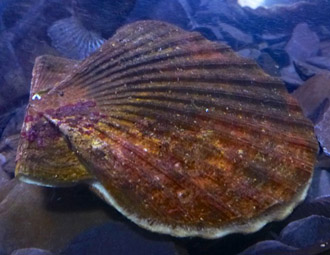Table of Contents
Buying
In the U.S., Federal regulations restrict the sale and consumption of only the adductor muscle as the edible portion of the scallop. This is because scallops are susceptible to accumulating toxins in internal organs and roe (reproductive organs) making them potentially unsafe for consumption.
Scallops are typically shucked on the boat to separate the edible part (the adductor muscle) from the rest of the shell and viscera which are discarded.
Both bay and sea scallops are sold by the pound. See labels like “U-10” or “U-30/40.” These signify the number of scallops it takes to make a pound.
Also see for labels for “wet packed” (preservative in brine solution) and “dry packed” (much fresher product) scallops. If but buy “wet packed”, give them a thorough rinse before cooking.
Sea scallops come in various colors depending on the species of scallop and its diet, including ivory, cream, or sometimes slightly orange or gray. Fresh scallops should have a mild, sweet smell, often indicative of their quality and freshness.
Storing
Fresh sea scallops will keep refrigerated for a few days. If you want to store scallops for a longer duration, freezing them is a good option.
Preparation and serving methods
Sea scallop has a sweet, rich taste that can be mild or briny. Cooked meat is opaque-white with a delicate flavor and firm texture.
Scallops are often pan-seared, grilled, or broiled. They can be enjoyed in various dishes, such as pasta, soups, stir-fries, or simply seared with butter and herbs.
Here are some serving ideas:
-
Serve pan-seared sea scallops with lemon wedges. Garnish with fresh herbs.
-
Grill scallops and serve immediately with favorite seasonings or sauces.
-
Baked sea scallops- In a bowl, mix together the melted butter, breadcrumbs, garlic, parsley, salt, and pepper. Bake for about 15-20 minutes until the scallops are opaque and the topping is golden brown. Serve hot with lemon wedges on the side.
Safety profile
-
Shellfish including sea scallops is a common food allergy and may affect around 1% of the population. Most of these allergic manifestations are mild to moderate in severity, ranging from hives (urticaria), tingling of the throat and mouth, swelling (angioedema), and gastrointestinal (vomiting, diarrhea).
-
Sea scallop has methyl-mercury levels of 0.003 Parts Per Million (PPM). According to the U.S. FDA guidelines for expectant and breastfeeding mothers, it is categorized into the “best choice”, allowing it to consume 2-3 servings per week. (Medical disclaimer).
Also read ≻≻-
≺≺ Shrimp nutrition facts and health advantages.
≺≺ Lobster nutrition facts and health benefits.
≺≺ Trout nutrition facts and health benefits.
≺≺ Anchovies nutrition facts and health benefits.
≺≺ Back to Seafood from Sea Scallops nutrition facts and Health benefits.
Further reading (Links opens in new window):
-
NOAA-Fisheries –Placopecten magellanicus.
-
The University of Maine-Maine Seafood Guide- Scallops-.
-
Omega-3 Fatty Acids: An Essential Contribution.


More Stories
Avocado Cacao Mousse – JSHealth
Janelle Brown on Garrison’s Mental Health Before His Death
How To Finally Beat Insomnia